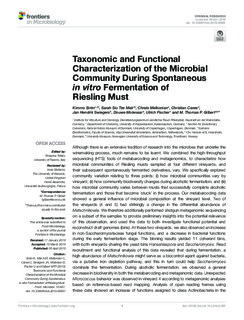| dc.contributor.author | Sirén, Kimmo | |
| dc.contributor.author | Mak, Sarah Siu Tze | |
| dc.contributor.author | Melkonian, Chrats | |
| dc.contributor.author | Carøe, Christian | |
| dc.contributor.author | Swiegers, Jan Hendrik | |
| dc.contributor.author | Molenaar, Douwe | |
| dc.contributor.author | Fischer, Ulrich | |
| dc.contributor.author | Gilbert, Marcus Thomas Pius | |
| dc.date.accessioned | 2020-01-06T08:20:16Z | |
| dc.date.available | 2020-01-06T08:20:16Z | |
| dc.date.created | 2019-11-29T20:45:59Z | |
| dc.date.issued | 2019 | |
| dc.identifier.citation | Frontiers in Microbiology. 2019, 10 (697). | nb_NO |
| dc.identifier.issn | 1664-302X | |
| dc.identifier.uri | http://hdl.handle.net/11250/2634904 | |
| dc.description.abstract | Although there is an extensive tradition of research into the microbes that underlie the winemaking process, much remains to be learnt. We combined the high-throughput sequencing (HTS) tools of metabarcoding and metagenomics, to characterize how microbial communities of Riesling musts sampled at four different vineyards, and their subsequent spontaneously fermented derivatives, vary. We specifically explored community variation relating to three points: (i) how microbial communities vary by vineyard; (ii) how community biodiversity changes during alcoholic fermentation; and (iii) how microbial community varies between musts that successfully complete alcoholic fermentation and those that become ‘stuck’ in the process. Our metabarcoding data showed a general influence of microbial composition at the vineyard level. Two of the vineyards (4 and 5) had strikingly a change in the differential abundance of Metschnikowia. We therefore additionally performed shotgun metagenomic sequencing on a subset of the samples to provide preliminary insights into the potential relevance of this observation, and used the data to both investigate functional potential and reconstruct draft genomes (bins). At these two vineyards, we also observed an increase in non-Saccharomycetaceae fungal functions, and a decrease in bacterial functions during the early fermentation stage. The binning results yielded 11 coherent bins, with both vineyards sharing the yeast bins Hanseniaspora and Saccharomyces. Read recruitment and functional analysis of this data revealed that during fermentation, a high abundance of Metschnikowia might serve as a biocontrol agent against bacteria, via a putative iron depletion pathway, and this in turn could help Saccharomyces dominate the fermentation. During alcoholic fermentation, we observed a general decrease in biodiversity in both the metabarcoding and metagenomic data. Unexpected Micrococcus behavior was observed in vineyard 4 according to metagenomic analyses based on reference-based read mapping. Analysis of open reading frames using these data showed an increase of functions assigned to class Actinobacteria in the end of fermentation. Therefore, we hypothesize that bacteria might sit-and-wait until Saccharomyces activity slows down. Complementary approaches to annotation instead of relying a single database provide more coherent information true species. Lastly, our metabarcoding data enabled us to identify a relationship between stuck fermentations and Starmerella abundance. Given that robust chemical analysis indicated that although the stuck samples contained residual glucose, all fructose had been consumed, we hypothesize that this was because fructophilic Starmerella, rather than Saccharomyces, dominated these fermentations. Overall, our results showcase the different ways in which metagenomic analyses can improve our understanding of the wine alcoholic fermentation process. | nb_NO |
| dc.language.iso | eng | nb_NO |
| dc.publisher | Frontiers Media | nb_NO |
| dc.rights | Navngivelse 4.0 Internasjonal | * |
| dc.rights.uri | http://creativecommons.org/licenses/by/4.0/deed.no | * |
| dc.title | Taxonomic and functional characterization of the microbial community during spontaneous in vitro fermentation of riesling must | nb_NO |
| dc.type | Journal article | nb_NO |
| dc.type | Peer reviewed | nb_NO |
| dc.description.version | publishedVersion | nb_NO |
| dc.source.pagenumber | 17 | nb_NO |
| dc.source.volume | 10 | nb_NO |
| dc.source.journal | Frontiers in Microbiology | nb_NO |
| dc.source.issue | 697 | nb_NO |
| dc.identifier.doi | 10.3389/fmicb.2019.00697 | |
| dc.identifier.cristin | 1754857 | |
| dc.description.localcode | Copyright © 2019 Sirén, Mak, Melkonian, Carøe, Swiegers, Molenaar, Fischer and Gilbert. This is an open-access article distributed under the terms of the Creative Commons Attribution License (CC BY). The use, distribution or reproduction in other forums is permitted, provided the original author(s) and the copyright owner(s) are credited and that the original publication in this journal is cited, in accordance with accepted academic practice. No use, distribution or reproduction is permitted which does not comply with these terms. | nb_NO |
| cristin.unitcode | 194,31,10,0 | |
| cristin.unitname | Institutt for naturhistorie | |
| cristin.ispublished | true | |
| cristin.fulltext | original | |
| cristin.qualitycode | 2 | |

